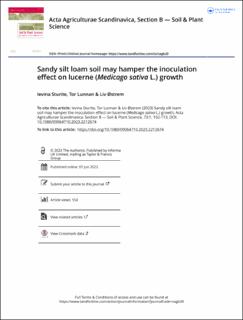| dc.contributor.author | Sturite, Ievina | |
| dc.contributor.author | Lunnan, Tor | |
| dc.contributor.author | Østrem, Liv | |
| dc.date.accessioned | 2024-01-11T12:09:31Z | |
| dc.date.available | 2024-01-11T12:09:31Z | |
| dc.date.created | 2023-06-30T10:23:56Z | |
| dc.date.issued | 2023-06-01 | |
| dc.identifier.citation | Acta Agriculturæ Scandinavica - Section B, Soil and Plant Science. 2023, 73 (1), 102-113. | en_US |
| dc.identifier.issn | 0906-4710 | |
| dc.identifier.uri | https://hdl.handle.net/11250/3111090 | |
| dc.description.abstract | Despite newly approved lucerne cultivars, this has not led to increased use of this legume in high-latitude agriculture. Challenges with inoculation by Rhizobium meliloti have been identified as a bottleneck to adaptation. Here we tested inoculation sources (ISs) with soil types and cultivars in pot and field experiments. During a one-year outdoor pot experiment, we tested the impact of IS (wet peat slurry and Nitragin Gold dry inoculation) and three soil types (sand, sandy silt and /peat soil) on nodule development, shoot and root growth and winter survival of one hybrid lucerne cultivar (‘Ludvig’). The pot experiment revealed that dry inoculation led to significant better plant growth, flower and nodule development as well as plant regrowth after winter survival. Peat soil appeared as the best growth medium and silty soil limited inoculation efficiencies. In field trials at two locations differing in soil characteristics using similar ISs, and three hybrid lucerne cultivars (‘Lavo’, ‘Live’ and ‘Lotte’) biomass yield during two ley years showed site as well as cultivar differences. Such environmental interactions in the field trials justify the use of adapted cultivars, and dry inoculation should be recommended for practical use replacing peat slurry inoculation. | en_US |
| dc.language.iso | eng | en_US |
| dc.publisher | Informa UK Limited | en_US |
| dc.rights | Navngivelse 4.0 Internasjonal | * |
| dc.rights.uri | http://creativecommons.org/licenses/by/4.0/deed.no | * |
| dc.title | Sandy silt loam soil may hamper the inoculation effect on lucerne (Medicago sativa L.) growth | en_US |
| dc.type | Peer reviewed | en_US |
| dc.type | Journal article | en_US |
| dc.description.version | publishedVersion | en_US |
| dc.rights.holder | © 2023 The Author(s) | en_US |
| dc.source.pagenumber | 102-113 | en_US |
| dc.source.volume | 73 | en_US |
| dc.source.journal | Acta Agriculturæ Scandinavica - Section B, Soil and Plant Science | en_US |
| dc.source.issue | 1 | en_US |
| dc.identifier.doi | 10.1080/09064710.2023.2212674 | |
| dc.identifier.cristin | 2159727 | |
| dc.relation.project | Norges forskningsråd: 255176 | en_US |
| cristin.ispublished | true | |
| cristin.fulltext | original | |
| cristin.qualitycode | 1 | |

